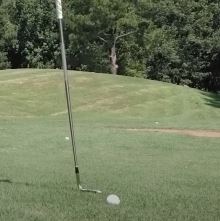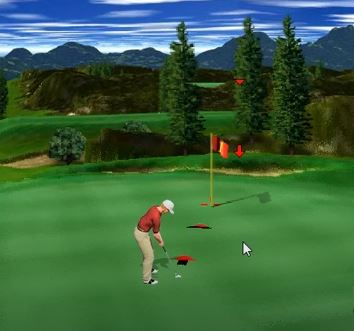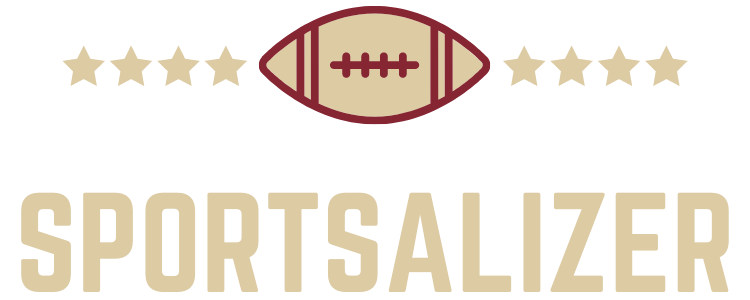Pin High in Golf: How to Aim For That Precise Shot!

We all have heard the two terms “hole high” and “pin high in golf” being used interchangeably. So what do they exactly mean, and are they synonymous? Yes, to answer all these questions, you need to continue reading the article, where we shall describe and explain these terms in detail.
Both the terms, be it hole high or pin high in golf, are used to describe a situation where a golfer hits the ball that traverses the correct distance, but due to lack of precision, the ball did not travel in the most accurate direction.
Contents
Pin High in Golf: A detailed explanation
If the basic idea of pin high in golf is not clear from the brief description, let us now give you a detailed explanation to make the concept crystal clear for you. What do we mean when saying “not the most accurate direction?” Imagine a situation where you have hit your Titleist v1 pro, and it covers the correct distance and reaches just the flagstick but does not fall in the hole. So what had happened in this situation, the distance covered by the ball is accurate, but the direction is not precise enough to make it fall into the hole.
The pin high in golf is often like a “consolation prize” for a golfer. It is so because your golf ball may end up in the left or right of the flagstick due to the wind or air friction. But, since the ball was hit “hard enough” to reach up there, it is rewarded a pin high in golf.
The hit is pin high if it is at an equal level as the pin. The ball doesn’t have to drop near the hole; it could lie eighteen feet to the right. On the other hand, a pin-high shot is on a straight line to the hole parallel to where the golfer struck from.
Hitting the pin high in golf is advantageous since it indicates that the player is aware of the distances to which their clubs travel. It is merely a matter of adjusting where one strikes their clubs, whether they hit pin high but not near the hole.
The reason behind the term “Pin High in golf”

Have you ever wondered whether this term has got to do anything with the height of the ball? The phrase Pin high in golf is slang in this sport. There is no such official term called “Pin High in Golf.” But there is a significance of the term “pin” in the phrase “pin high in golf.”
Not every golf course looks the same. If you are a player or a regular audience of golf, you must know this fact, the shapes of the golf course shapes vary from place to place. In the enormous stretch of land, it is impossible to see the hole from a distance. Thus, the flagstick is used to mark the spot in the golf course. It acts as a pin to mark the hole, hence the name.
Does Pin High in Golf indicate the “depth” of a shot?

When a player takes a shot, and it goes and hits the green, the pin high in golf is not going to tell the player whether the shot taken has landed your ball is on the green, whether it’s in the front, center, or back, or even whether it’s left or right of the hole. Your ball must be level with the flagstick for the rules to apply. To determine the depth of your approach shot, you must first determine if the hole is cut in the front, middle, or back.
So if not this, then how do the golfers estimate various statistics? Thanks to the evolution of technology, players are now about to do that with the help of various GPS devices that are available commercially. Th devices that we are referring to here could be GPS watches, different kinds of mobile phone apps, portable and affordable rangefinders, or even handheld GPS devices. The golfers use all these devices to understand the ball’s distance from the hole or at least the specific location on the golf course. Previously, professional golfers or golf hobbyists used “100-150 yard markers” to get their ball in the pin high in golf.
If you have been playing golf for a long time, you are probably already aware of the “pin sheet.” If not, this term may sound new to you; let us explain “pin sheet” briefly. A pin sheet is a sheet of paper which the golfers are proved in some golf courses, if not all. The main objective of the pin sheet is to make the golfers understand the location of the hole in the golf course. By developing a few skills, one can quickly achieve the pin high in golf by studying the pin sheet carefully.
The Bottom Line
In a nutshell, we can say that the phrase pin high in golf is used to describe the ball’s location, especially when it is not close to the pin but lies in line with it at a distance of 100-150 yards. If one can achieve the pin high, it means they have chosen the “right club” for the shot. However, if you find yourself frequently achieving the pin high in golf, it does mean that you are too good with the control on the distance, but there is still room for improvement for precision over the direction.
In golf, the terms pin and flag are interchangeable. When it comes to equipment and rules, we all know how severe the United States Golf Association or as commonly referred to as USGA, can be.
Flagsticks, on the other hand, are not quite as involved. A flagstick should be roughly seven feet tall, according to the USGA. However, several golf courses utilize an extremely long pin on greens over a high mound or down in a gulley for visibility.
FAQs on Pin High in Golf
In golf, what happens if you hit the pin?
You will receive a two-stroke penalty in stroke play if you hit the flag and a hole loss in match play. If you are off the green and hit the flag, there is no penalty until you ask anyone to tend it, and they do not pull it out. They would be penalized if they did so.
Is it preferable to keep the pin in or remove it?
Studies show that you will hole a more significant proportion of putts when you leave the flagstick in. The possible explanation for this effect is that when a putt hits a fiberglass flagstick, a substantial amount of energy is lost from the putt’s speed.









